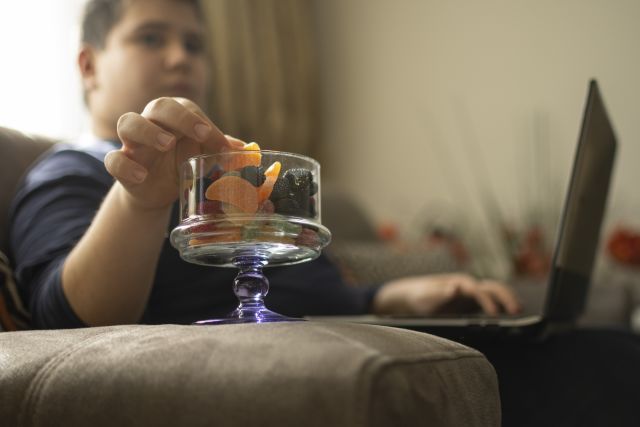Updated on October 23, 2024.
You may have heard about the national childhood obesity epidemic. Nearly 20 percent of children and adolescents in the United States ages 2 to 19 years have obesity, according to a 2021 report published by the Centers for Disease Control and Prevention (CDC) that looked at data captured betwen 2017 and 2020.
Broken down by age group, 22.2 percent of adolescents ages 12 to 19 had obesity during that time span, as did 20.7 percent of children ages 6 to 11 years.
Even young children are affected. Among kids ages 2 to 5 years of age, 12.7 percent had obesity during 2017 to 2020.
The consequences of childhood obesity
A number of conditions—including high cholesterol, asthma, a weaker immune system, arthritis, cancer, heart disease, and diabetes—can develop if the body is carrying extra weight. There are also emotional and mental health effects associated with childhood obesity.
The American Academy of Pediatrics (AAP) explains that society’s obsession with thinness and beauty can cause children as young as 6 to consider another child who is overweight as less pleasant to be around. That child may also have more trouble making friends compared with a child who is not overweight.
Many children with overweight or obesity, for example, are bullied or teased for their appearance and may experience low self-esteem or depression as a result. The lack of self-confidence may lead to feelings of shame or self-blame about their body, along with poor performance in school.
But taking some steps early on to help your child maintain a healthy weight can help protect their long-term health, according to Uwe Blecker, MD, a pediatric gastroenterologist in Bakersfield, California.
First, recognize the warning signs
When discussing a child who is overweight, some parents will say it’s “baby fat" or "just a stage." But it’s important to be on the lookout for signs that your child's weight may be contributing to other health issues. Make an appointment with your pediatrician if you notice these signs:
- Snoring at night, or trouble sleeping
- Shortness of breath
- Fatigue
- Trouble exercising or walking up stairs
Your pediatrician will help you understand if your child is at an unhealthy weight for their age and height.
“We look at their age on the BMI chart," explains Dr. Blecker. BMI, or body mass index, is a measure of body fat based on height and weight. Both the CDC and the AAP recommend using BMI to gauge children older than 2.
"A child is overweight when their BMI is above the 85th percentile and obese if their BMI is at or above the 95th percentile,” Blecker explains.
Develop a weight-management plan
Helping your child manage their weight should begin and end with your pediatrician, says Blecker. He points out that a child’s age and how much growing they still need to do should be taken into consideration.
“We look at three age categories: 2 to 5 years, 6 to 11 years, and 12 to 18 years,” Blecker says. “Children ages 2 to 5 have a very significant amount of growth in front of them.” And because they have a lot of growing to do, being overweight may not be a permanent problem.
“When we have an obese child in that age group,” he adds, “we don't necessarily work on losing weight, we just try to decrease or stop the weight gain.”
Once a child hits age 12 or is going through puberty, working on weight loss may become a more pressing issue. They’ll likely need to make changes to their habits, Blecker says. "The big things are avoiding fried food and sugary drinks and adding in more fruits and vegetables."
An appropriate exercise plan will also depend on your child’s age and weight.
“We really can’t ask kids who are severely overweight to do significant physical activity,” says Blecker. He recommends a gradual approach, starting with walking. As children lose weight and become more fit, their level of physical activity may increase.
Be a role model
Once you've identified that your child needs help managing their weight, setting a positive example with diet and exercise is key.
"Obesity interventions do not work if the parents don't participate," Blecker emphasizes. He notes that he's seen teenage patients who want to lose weight but their parents continue to buy and serve them chips and soda. "That is not going to work."
Be mindful of added sugar
Sugary beverages, in particular, are a dietary pitfall that should not be overlooked, especially when it comes to kids. Sweet drinks remain a staple in many children’s diets.
A 2019 research review published in Annals of Nutrition and Metabolism reported that about 80 percent of adolescents drink sugary beverages every day. In fact, in the U.S. alone, beverages with added sugar or artificial sweeteners made up 62 percent of children’s drink sales in 2018, according to an 2019 report from the University of Connecticut’s Rudd Center for Food Policy & Obesity.
A 2020 study published in Academic Pediatrics used medical records from over 22,000 children to analyze how sugary drinks contributed to childhood obesity. The researchers found that 43 percent of children drank at least two sugary beverages a day. Kids who had at least three sugary drinks a day had higher BMIs than those who drank less than one a week.
Meanwhile, healthier alternatives, such as 100-percent fruit juice and juice diluted with water, accounted for only 38 percent of kids’ beverages, according to the University of Connecticut report. Researchers gathered this data by assessing the top-selling brands of children’s drinks, which included fruit drinks, flavored waters, drink mixes, 100-percent fruit juice, juice-water blends, and sparkling water.
“If children aren’t exposed to sugary drinks, they typically don’t want them," Blecker says.
It may be unrealistic to assume that your child or teenager won’t try a soda or a sugar-laden latte once in a while when they’re out with friends, at a birthday party, or another event. Just be sure they aren't in the habit of drinking them at home. Instead, try offering water with real fruit slices or unsweetened soda water, coconut water, or tea.
Maintaining a healthy weight can become a family goal and may inspire group activities. When you are at home, try cooking a wholesome meal as a family, or make a habit of walking around the neighborhood every evening. You’ll spend more time together, while working to improve your well-being.







